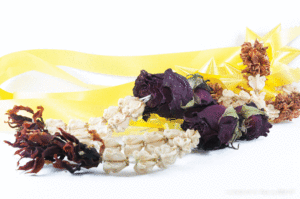
Making your own potpourri is a fun way to get the blend you want, make a gift more personal, and more natural and environmentally friendly.
Creating potpourri doesn’t usually come to mind until after the gardening season is over and our minds are turning to holiday gift giving.
However, as you plan your spring garden planting you can confidently say, “I’ll take ‘potpourri’ for $1,000” because you’ll be able to come up with the perfect custom blend for your nose and the noses of those you love.
There are two different types of potpourri, simply referred to as “dry” and “moist.”
Dry is a mix of flowers, leaves, spices and can be enhanced with essential oils.
The wizened leaves are usually pretty enough to be decorative in a bowl or display piece.
Moist potpourri is tucked away in containers or sachets as it usually isn’t quite as pretty, but the fragrance does last longer.
However, the newest trend of encasing the flowers with small sheets of beeswax is too gorgeous to hide.
Like any other scent-driven item, potpourri has endless varieties and combinations because everyone gravitates toward something different.
With a variety ranging from flowery to herb heavy, think about what plant palettes are pleasing to you to create one featuring scents that you really love.
What scents do you enjoy most during spring or tend to miss in the colder months? What are you drawn to when you treat yourself to a new candle or scented soap?
Jot down some notes.
Now that you know what you want it to smell like ideally, do a bit of research.
Some flowers that smell lovely in your garden might not necessarily turn into lovely potpourri either because they lose their scent when dried or worse — their scent turns to stink.
Hyacinths, violets and tea roses fall into those categories when dried.
Other flowers work exceptionally well, both for looks as well as smell, such as old fashioned roses, geraniums and even hydrangeas.
Don’t forget to sprinkle some extra herbs into your garden such as basils, thyme, rosemary, or eucalyptus.
Lavender and chamomile are great for blends that will be in a bedroom, as they both are known for their relaxing scents.
For visual interest in a dry mix, make sure you have some larger petaled flowers as they keep their shape better when dried.
For color, add in marigold, larkspur, cornflowers and other vibrant petals.
Try harvesting flower buds of a rose or whole flower heads of a black-eyed Susan or petite sunflower.
If you absolutely love the looks of a fragrance challenged flower, you can still use it for texture and enhance the scent via oils.
As your garden grows, you can also set some potpurri fillers aside like pinecones, feathers or even strips of bark.
Dry some of the flowers from a wedding or anniversary bouquet to use in your mix as well and keep the ribbon or any adornments from the arrangement that could absorb scent as well.
Another personal twist for gifted potpourri can be plants from places that are special in and of themselves, like hydrangeas from a grandmother’s garden, or “East Coast” flowers sent to a loved one now living out of the growing region.
Pay attention to the timeframe your flowers will be at their peak to process, especially if varieties will be ready at different weeks.
The optimal time for creating your potpourri is when your flowers are freshly picked and dried for a few days, but aren’t so dry and brittle the stems are breaking.
Take into account the time your blends will take to cure if you plan to give as gifts.
Making your own potpourri is a fun way to get exactly the blend you want, make a gift more personal, and more natural and environmentally friendly than store-bought.
With thoughtful preparation, you’re sure to have fun experimenting with your potpourri project when the gardening season is over.



